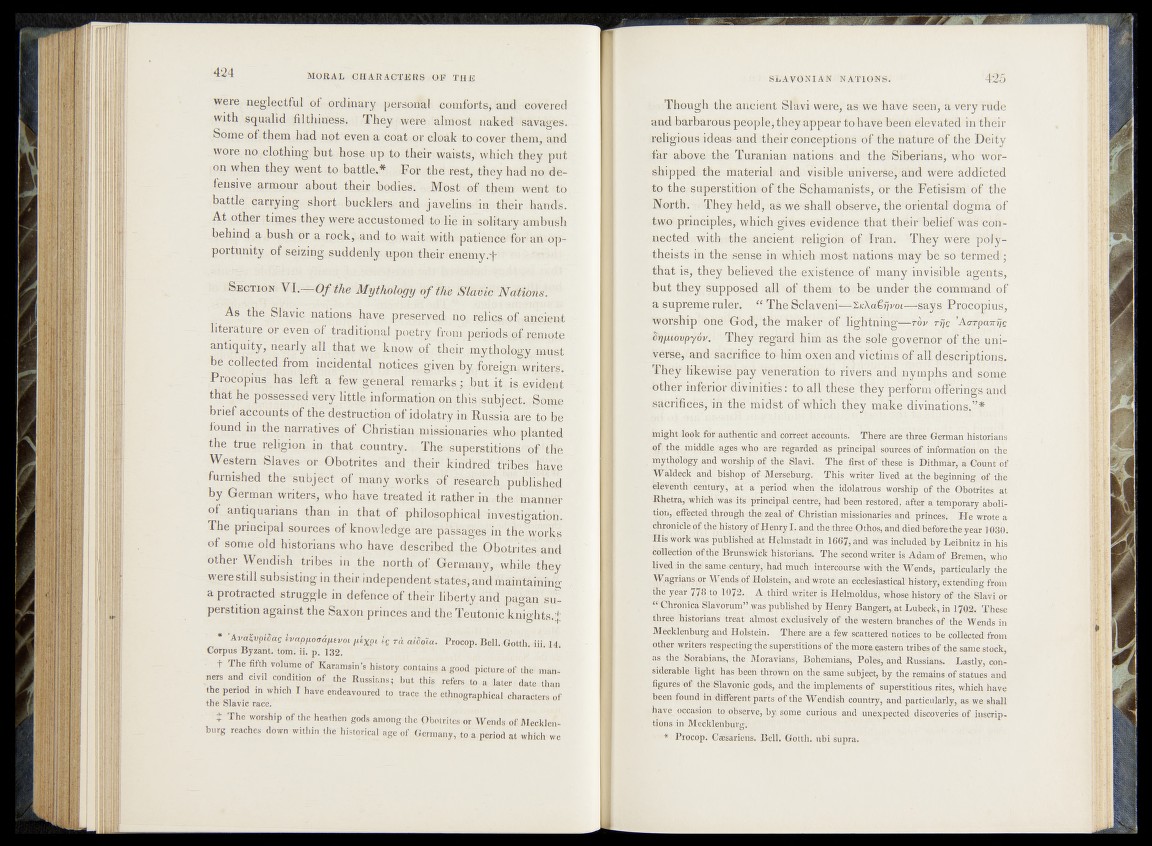
were negleetfpl of ordinary perscoÉil comforts^ aad covered
with squalid filthiness. They f were naked' savages.
Sdrhe of them had not even a coat or cloak to cover them, and
wore, no clothing but. hose up to their waists, which they put
ipn when they went to battle,* . .Fob: the* rest,, they had no defensive
armour about their bodies. Mbstsof them ,w^it tb
battle carrying shbrt^bncklers and javeMnsi in their hands.
At other times they were accustomed to lie in solrtaiy ambush
behind a.bush or a ■ rockÿand to wait with patiênéérfbr arltop-
portunity of seizing suddenly upon their enemy.'+
S ection VI. O f the Mythology o f the S ta tic N (M w k s \
As the Slavic nations have preserved no rpi io.a.nf ;ampjp
literature or even of traditional poptry,from periods3of,remote
antiquity, nearly all that we know of Üiej^mythoJogy must
jlë coilected from incidental notices^giyeni by^Q£eigr^writers.
Prbicopius has left a few general rpmark^ ^ ^pt.it. i^evld&t
that he possessed very little mfonhatioq Pft.this
brief accounts of the destruction of idolatry in Russia* are to be
found in the narratives of Christian missionaries who planned
the true religion in that country. Theusuperstitiohs' of 'th'è
Western Slaves or Obotrites and tfieif; kindred' feb ej^ay e
furnished the subject of many works o f ”r|s ||^ (^ J published
by German writers, who t i ^ e d - # r^heE;itk#tfcelfcaarii
of antiquarians than in that of philosophical iüvé|ïifàti«hl.
The principal sources of
of some old historians who have, descjibecl tke .Obotrites and
other Wendish tribes in the north of Germany, while they
were still subsisting in their- independent states; afid hiahiïâfinfi^
a protracted struggle in defenee of their liberty/aïïd pâ^àp superstition
against the Saxon princes and jjjg T e u S ^ in ig h t« ^
* AvalvplMç ivapfioaâjiivoi /riypi iç T^alScna. Procop. Bell. Gottb. iii, 14.
Corpus Byzant. torm il. p. 1 3 2 ,
- f ThAfifUi volume of Earamsin’s history contai^ pgopd piptureipf the man-
»ers and civil conditM pf^the Russians; but thig refera to.a later date than
the period in which I hare*endeavoured’ to trace the ethnographical characters of
the Slavic race.
Î The worship of the heathen gods among th ê^ o tr ià or Wends pf hlecklem
burg reaches down within the' historical age of. Germany, to a period at which we
Though the ancient Sl'avi were, as we have seen, a very rude
and barbarous people, they appear to have been elevated in their
TeligiouS ideas- and their conception^ b f the nature of the Deify
far above, the Turanian nations, and th é ;Siberians, who worshipped;
the material i n d 5 visible universe, and were Addicted
to the,‘superstition1 oPfhe Schamafaists, of the Fetisism of the
North. . Theysheld', >as- we shall obééfVe, tbe'oriental dogma bf
two principles, which gives evidence'that thebrbelief was connected:
with.:the an cien t religion tóf Iran. They wérd
theists in the^en-seum!*which®iop%mations may bb'sb^tërmed^j
that is, they, believed the- eXisrtènee>of many invisible agents,
but they;>Supposed all of tbem^to tbe-, under the command of
a supreme ruler. “ The Sclaveni—^B»cXa€)>pr—says Procopius,
Worship one God, th e Shaker of lightning —to v rijs ’Aerpcnrijs
&)fuovpyëv. They regard him as thefsb'fegovernor oftFe-uni-
verse, and sacrifice to-him oxen a’ntj victims of all. descriptions.
They like wish'!pay venerationfo rl ver s 'l f d , ,ny in phs* and sorme
-bthei* inferior1 diVinifibs^fo all ^ e ^ lo p y 'perform offeridgi and
’èöfcnfiefej^iih the1rnidst of which;‘they make diviqatioh^.’’*
bright look for audiëntie and coirect accounts. There are three German historians
VfLffrf cpii^le. iages who regarded as principal source^ of'mroitaabdil on the
the Slavi. The first.oftthese is Bithmar, a Gbustof
. Waldeck and bishop of Merseburg. This writer lived at.the.beginning pf the
e&v'entK; céiitury, at a period when the' idolatrous worship of tW Obotrites at
Rhetr% ;whMiwasiits'principal centre, had been restored, .after a temporary abedi-
t^n,?effected through the zeal of, Christiari missionaries-and pfinces. I Hè wrote a
chronicle of the history of Henry I. and the.three €}thos, and died before the year 1030.
His work was published at Helmstadtln 1667, and was included by Leibnitz in his
collection df the’ Brunswick feisforians. The second writer is A,dam of Bremen, who
,^ed;in;;?thetsan^e,-cenW% had iriuéh' Ihfercoübe withdie Wends, particularly thè
Wagri^ijs.or W^dsyf Hnlsteihv'ar4 w,rofè;an' ecclesiastical' history!-extending froin
Ihe year 7k78 tp 1072. A.;third, writer is Helmoldus, whose, history of the Slavi ór
Chronica Slavorum” was published by Henry Bangert,at Luheck, in 1702. These
three' historians treat almost exclusively of the western branches of the Wends ip
Mecklenburg and Holstein. There are a few scattered hprijjes to be collected from
other writers respecting'the sup'erstitions of the moru eastern tribes of the same stock,
as the Sorabians, the Moravians, Bohemians, Poles, and Russians. Lastly, considerable
light has beén throwri on the same subject! t»y the remains of sjta^ï^s a^d
figurés of the Slavonic gods, and the'implements of superstitious, rites! which have
been found in, ddfférent parts of the Wendish country, and particularly, as we.shall
have_ occasion to observe, by some curious and unexpected discoveries of iuscrip.
ti'ons in* Mecklenburg: '
* i Procop. Cassarietts. Belli.' Gbtthi libi supra.